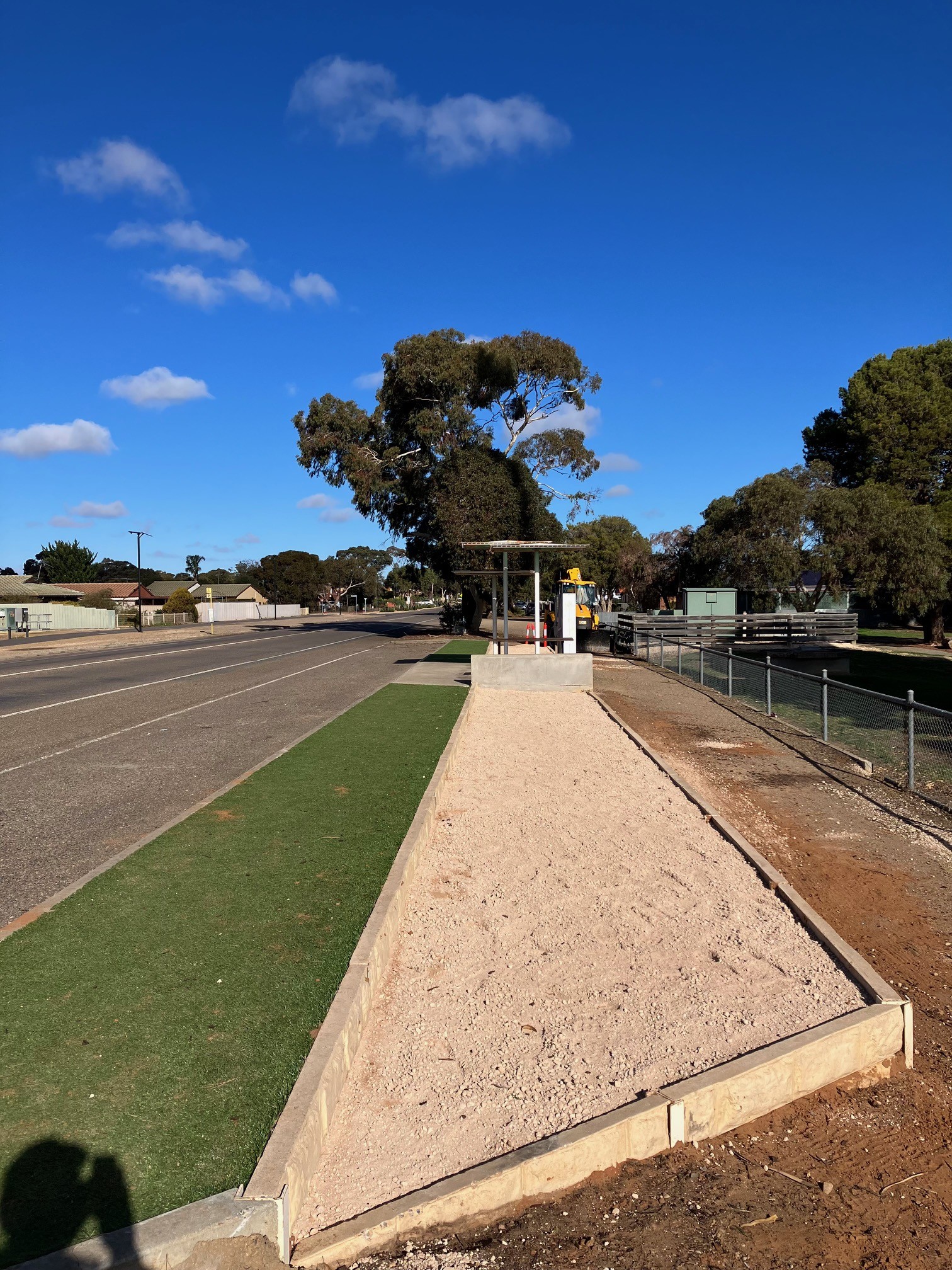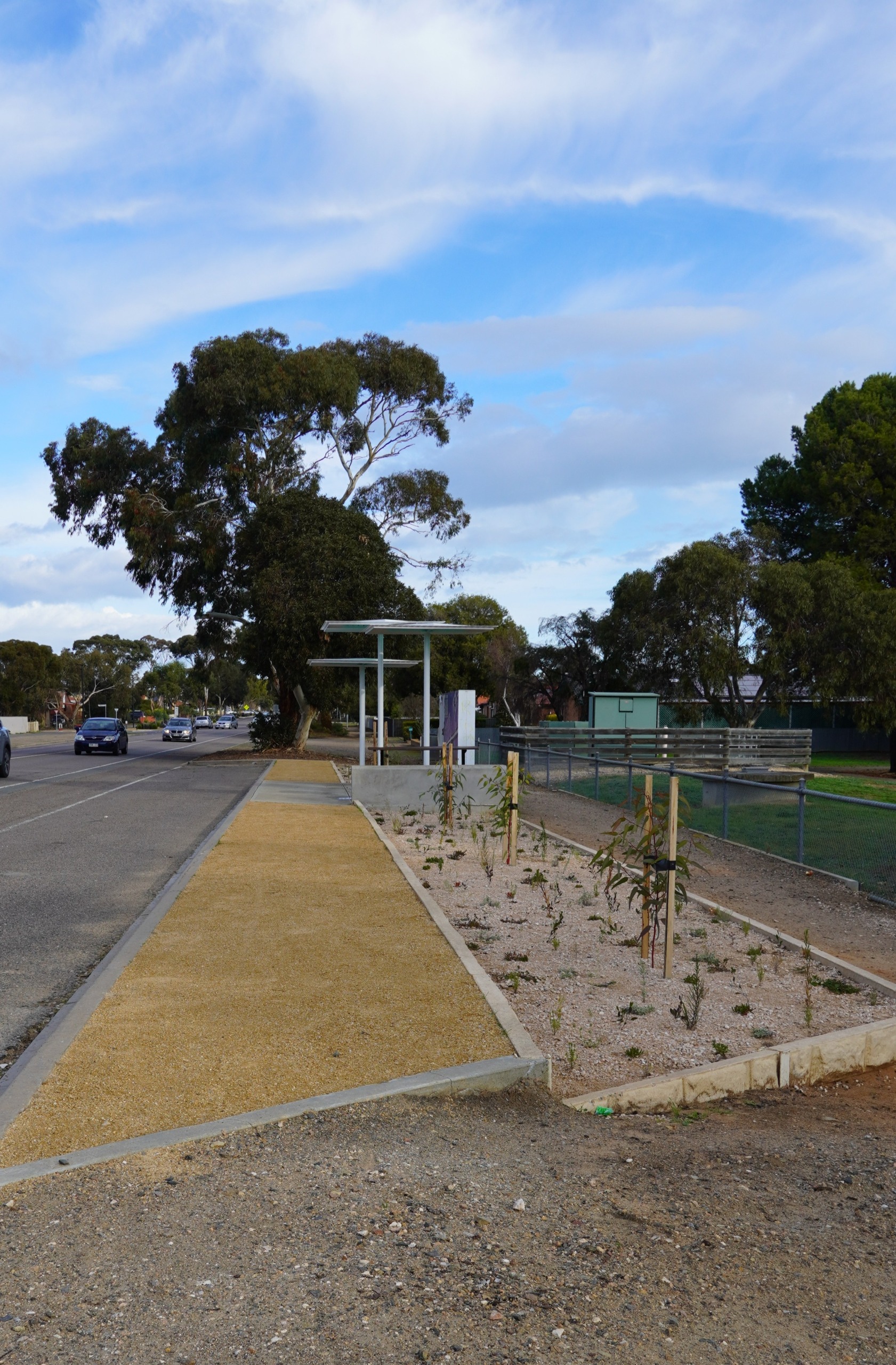Base layer (<0.5 m height)
- Enchylaena tomentosa var. tomentosa
- Disphyma crassifolium
- Prostanthera aspalathoides
- Atriplex semibaccata
- Chrysocephalum apiculatum Prostrate
- Goodenia varia
- Scaevolia humilis
Everyone can play a role in greening and adapting our towns and cities, learn more about this project and share your thoughts with us.
Join the conversation today. Create an account or log in to share your thoughts and ideas.
This project is testing a new style of urban planting using native Australian shrubs and small trees to create beautiful, low-maintenance landscapes that use less water.
This is the first time the Woody Meadows method is being trialled in SA. It will provide information on how well the dense planting style performs in local soils and conditions.
The Rural City of Murray Bridge council will learn as the planting grows, which plants will grow well, and which plants might not do so well. The landscape board is working with council to monitor the plants growth rates, and the amount of water used to establish them.
These plantings are designed to be low water use and low maintenance when established, and form part of a national network of trials being delivered collaboratively by the University of Melbourne. Trials have been running since 2013 and the Woody Meadow Guidelines can support anyone to plant a woody meadow of their own.


Woody meadows are layered shrub plantings using native species, maintained by coppicing (hard pruning to 10-20 cm) to promote flowering and create dense canopies to exclude weeds. The planting method has been developed and trialled by the University of Melbourne.
This structure improves biodiversity, keeps weeds out, is low maintenance and low water use, and looks great year-round. The mix of flowering plants can boost biodiversity and make small areas more attractive for communities.
All plants are native and grown locally in Murray Bridge. A total of 436 plants have been planted in this trial. They’re planted densely to block weeds and reduce watering needs. The plants around the street trees will be cut back (coppiced), but the street trees themselves will not be coppiced.
Yes! Many of these species do well in urban gardens if:
Soil types can affect how well native plants can grow, we recommend contacting State Flora for advice on any special requirements
The Murraylands and Riverland Landscape Board acknowledges Aboriginal people as the First Peoples and Nations of the lands and water that we live and work upon, and we pay our respects to their Elders past, present and emerging. We acknowledge and respect the deep spiritual connection and the relationship that Aboriginal and Torres Strait Islander people have to Country.

Have questions or want to learn more about a project, contact us below:
| Phone | 08 8532 9100 |
|---|---|
| Website | landscape.sa.gov.au/mr |
| In writing | Unit 5-6, Level 1 Sturt Centre, 28 Vaughan Terrace, Berri SA 5343 |
This site is owned and operated by Murraylands and Riverland Landscape Board using software licensed from Social Pinpoint. For details on how Murraylands and Riverland Landscape Board collects and protects your personal information, refer to their Privacy Policy below. For details of how Social Pinpoint may access personal information, please refer to Social Pinpoint’s Privacy Policy.
View the Murraylands and Riverland Landscape Board Privacy Policy.
The following Terms and Conditions govern the use of Flow. The software platform is owned by Social Pinpoint Pty Ltd and operated by us, Murraylands and Riverland Landscape Board.
By accessing and using this site, you are choosing to accept and comply with the Terms presented throughout this agreement as well as the Privacy Policy and Moderation Policy. These Terms apply to all visitors and users of this site. Linked sites, affiliated services or third party content or software have their own Terms that you must comply with. If you disagree with any of the Terms presented in this agreement, you may discontinue using the site immediately.
If you are under 18 years old, please ensure that your parent or guardian understands and accepts these Terms and Conditions (including the Privacy Policy and Moderation Policy).
What are the conditions with a user’s account?
While using the site, you must not violate any applicable laws and regulations. It is our duty to protect the confidentiality of content you provide on our site in accordance with our Privacy Policy. When you create an account with us, you must always provide us with accurate information. Failure to provide accurate information violates the Terms, which may result in immediate termination of your account on our service. You are responsible for protecting your own password you use for this site and for any activities done under that password. Unauthorised use of your password or account must be immediately reported to us. In some cases, we or our agents may require access to your user accounts to respond to technical issues.
We are not responsible for the content on the site that has been provided by the users of the site. Any content posted by you is subject to the rules of our Moderation Policy. Your contribution to the site may be edited, removed or not published if we consider it inappropriate (refer to Moderation Policy). Contributors should also be aware that their posts may remain online indefinitely. Where practical, you may choose not to identify yourself, deal with us on an anonymous basis or use a pseudonym.
What do we require from our users?
You must understand and agree that, without limitation:
Can your account be suspended or terminated?
We may terminate or suspend access to your site and/or account immediately, without prior notice, including without limitation if you breach the Terms. We may immediately deactivate or delete your account and all the related files and information in your account. After your account has been terminated, the content you have posted may also remain indefinitely on the site.
If you want to terminate your own account, please send an email to mrengage@sa.gov.au.
Governing Law
These Terms shall be governed in accordance with the laws of South Australia, Australia, without regards to its conflict of law provisions.
Indemnification
Murraylands and Riverland Landscape Board, its subsidiaries, affiliates, officers, agents, licensors and other partners are not responsible for any loss, liability, claim, or demand, including legal fees, made by any third party due to or arising from a breach of this agreement and/or any breach of your representations and warranties set forth above.
What content do we own?
This website contains the copyrighted material, trademarks, patents, trade secrets and other proprietary information (“Intellectual Property”) of Murraylands and Riverland Landscape Board and its suppliers and licensors. Murraylands and Riverland Landscape Board owns and retains all proprietary rights in the intellectual property. All intellectual property in the content of this site including without limitation to text, software, source code, pages, documents and online graphics, photographs, sounds, audio, video and other interactive features are owned by or licensed to us.
Any original content that you submit or post on our site may be made available to the public and allows users to share your content (with the end user acknowledging your contribution) under the Creative Commons Attribution-ShareAlike 4.0 Australian License.
Except for Intellectual Property which is in the public domain or for which you have been given written permission, you may not copy, alter, transmit, sell, distribute any of the Intellectual Property on this site.
We are not responsible for your communications or dealings, including payment and delivery of goods or services, with a third party found via our website. Any loss or damage incurred from those communications or dealings are solely between the user and the third party.
Disclaimer and Warranties
Users must agree that you use of the site is at your own risk. We make no warranty that the site will meet your requirements or be uninterrupted or error-free. Any material that the user downloads through the site is done at their own risk and are responsible for any damages to their computer system or loss of data.
What happens if these Terms change?
We reserve the right, at our sole discretion, to modify or replace these Terms at any time without notice. The most recent version of the Terms can be seen on this page. By continuing to access or use our site after those revisions become effective, you agree and will comply to the revised terms. If you do not agree to the revised terms, please discontinue using our site.
Contact Us
If you have any questions about these Terms, please contact us at mrengage@sa.gov.au
Enter your email address below. We will send you instructions to reset your password.
Back to Log in
Creating an account helps us better understand your needs and the needs of the community.
Already have an account? Log in now
Thank you, your account has been created.
Completing the questions below helps us better understand the diverse range of people who contribute their ideas. The questions are optional.
You’re using an outdated browser.
Some features of this website may not work correctly. To get a better experience we strongly recommend you download a new browser for free:
Would you like to follow this project to receive email updates?